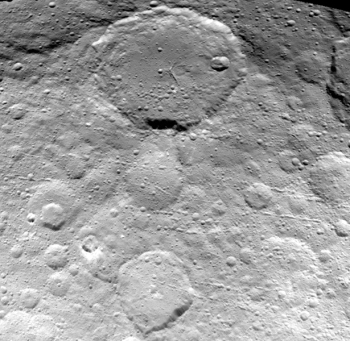It looks like the Moon!

Cool image time! Dawn has now swooped down to 3,200 miles, and provided a very nice image of the cratered surface of Ceres. Though it does appear to resemble the Moon, there are some differences that come to mind if you take a close look at the full resolution image. The surface appears smoother. All of the craters appear worn or eroded or less rugged. Also, there are no mountains. The terrain resembles the Moon’s lowlands or maria, but more so.
Note that the region in this picture is tantalizingly close to the double bright spot, but does not include it. Because Dawn is still easing its way into its first survey orbit of 2,700 miles elevation, it only takes pictures when it stops firing its ion engine, which it is doing almost all the time to get where it wants to be. Thus, they apparently only had time for this image.
The spacecraft enters its mapping orbit on June 3. Expect some cool images, including the first good images of the double bright spots, shortly thereafter.
On Christmas Eve 1968 three Americans became the first humans to visit another world. What they did to celebrate was unexpected and profound, and will be remembered throughout all human history. Genesis: the Story of Apollo 8, Robert Zimmerman's classic history of humanity's first journey to another world, tells that story, and it is now available as both an ebook and an audiobook, both with a foreword by Valerie Anders and a new introduction by Robert Zimmerman.
The print edition can be purchased at Amazon or from any other book seller. If you want an autographed copy the price is $60 for the hardback and $45 for the paperback, plus $8 shipping for each. Go here for purchasing details. The ebook is available everywhere for $5.99 (before discount) at amazon, or direct from my ebook publisher, ebookit. If you buy it from ebookit you don't support the big tech companies and the author gets a bigger cut much sooner.
The audiobook is also available at all these vendors, and is also free with a 30-day trial membership to Audible.
"Not simply about one mission, [Genesis] is also the history of America's quest for the moon... Zimmerman has done a masterful job of tying disparate events together into a solid account of one of America's greatest human triumphs."--San Antonio Express-News

Cool image time! Dawn has now swooped down to 3,200 miles, and provided a very nice image of the cratered surface of Ceres. Though it does appear to resemble the Moon, there are some differences that come to mind if you take a close look at the full resolution image. The surface appears smoother. All of the craters appear worn or eroded or less rugged. Also, there are no mountains. The terrain resembles the Moon’s lowlands or maria, but more so.
Note that the region in this picture is tantalizingly close to the double bright spot, but does not include it. Because Dawn is still easing its way into its first survey orbit of 2,700 miles elevation, it only takes pictures when it stops firing its ion engine, which it is doing almost all the time to get where it wants to be. Thus, they apparently only had time for this image.
The spacecraft enters its mapping orbit on June 3. Expect some cool images, including the first good images of the double bright spots, shortly thereafter.
On Christmas Eve 1968 three Americans became the first humans to visit another world. What they did to celebrate was unexpected and profound, and will be remembered throughout all human history. Genesis: the Story of Apollo 8, Robert Zimmerman's classic history of humanity's first journey to another world, tells that story, and it is now available as both an ebook and an audiobook, both with a foreword by Valerie Anders and a new introduction by Robert Zimmerman.
The print edition can be purchased at Amazon or from any other book seller. If you want an autographed copy the price is $60 for the hardback and $45 for the paperback, plus $8 shipping for each. Go here for purchasing details. The ebook is available everywhere for $5.99 (before discount) at amazon, or direct from my ebook publisher, ebookit. If you buy it from ebookit you don't support the big tech companies and the author gets a bigger cut much sooner.
The audiobook is also available at all these vendors, and is also free with a 30-day trial membership to Audible.
"Not simply about one mission, [Genesis] is also the history of America's quest for the moon... Zimmerman has done a masterful job of tying disparate events together into a solid account of one of America's greatest human triumphs."--San Antonio Express-News


Note the “grooves”. Looks a bit like the “grooves” on phobos.
I’ve hypothosize the grooves are trails left in the regolith from boulders rolling away from low speed impacts. Since gravity is so low, they’d just bounce and roll around the surface moving in a straight line around the curve of the body until all their energy was exhausted.